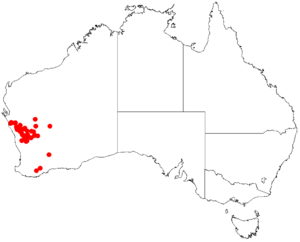Darwinia capitellata facts for kids
Quick facts for kids Darwinia capitellata |
|
|---|---|
| Scientific classification | |
| Genus: |
Darwinia
|
| Species: |
capitellata
|
 |
|
| Occurrence data from AVH | |
The Darwinia capitellata is a special plant that belongs to the Myrtaceae family, also known as the myrtle family. It's found only in the south-west part of Western Australia, which means it's endemic to that area.
This plant is a bushy shrub with many branches. It looks a lot like another plant called Darwinia diosmoides. However, Darwinia capitellata has some key differences. Its flowers are arranged differently, it has more branches, and its younger stems have clear oil glands. Also, the small, paper-like leaves near its flowers, called bracteoles, are thinner. Scientists first realized it was a separate species when they found that its cells had a different number of chromosomes compared to D. diosmoides.
Contents
What Does Darwinia capitellata Look Like?
Darwinia capitellata is a shrub that can grow up to about 1 meter (3 feet) tall. It has many branches, and its leaves are grouped together near the ends of these branches. The younger branches have special oil glands that you can easily see.
The leaves themselves also have clear oil glands and a small stalk. They are usually about 2.5 to 4.5 millimeters (0.1 to 0.2 inches) long and 0.5 to 1.0 millimeter (0.02 to 0.04 inches) wide.
The Flowers of Darwinia capitellata
The flowers of this plant grow in clusters near the ends of the branches. These clusters are a bit like a flat-topped bunch, different from how other Darwinia species arrange their flowers.
Each flower has two small, thin, papery bracteoles (leaf-like parts) around it. These are about 2.3 to 4.0 millimeters (0.09 to 0.16 inches) long and 0.5 to 1.0 millimeter (0.02 to 0.04 inches) wide. They fall off as the flower gets older.
The petals (the colorful parts of the flower) are egg-shaped and white. They are about 1.8 to 2.3 millimeters (0.07 to 0.09 inches) long. Inside the petals are 10 stamens (the male parts of the flower) and staminodes (stamens that don't produce pollen). The lower part of the style (the stalk that supports the stigma, which collects pollen) is also enclosed by the petals.
The style sticks out from the rest of the flower and is about 4 to 6 millimeters (0.16 to 0.24 inches) long. It has a band of tiny hairs near its tip. Darwinia capitellata flowers between August and November. After flowering, it produces a dry, non-fleshy nut that holds a seed about 1 millimeter (0.04 inches) long.
How Darwinia capitellata Got Its Name
The scientific description of Darwinia capitellata was first published in 1983. This was done by a very important plant scientist named Barbara Rye in a journal called Nuytsia. It was her first time publishing a new species!
The very first plant specimen used to describe this species, called the type specimen, was collected by Charles Gardner near Paynes Find.
Scientists first realized this plant was a new species because some of its specimens had 12 chromosomes. This was different from Darwinia diosmoides, which usually has 7 or 14 chromosomes. Later, they looked closely at the plants' shapes and features (their morphology) to confirm it was indeed a separate species.
The second part of its scientific name, capitellata, comes from a Latin word. Capitatus means "forming a head," and the small ending "‑ell‑" makes it mean "forming a small head." This name refers to how the flowers are arranged in small clusters on the plant.
Where Darwinia capitellata Lives
This type of darwinia plant grows in sandy areas, sometimes even on sandstone rocks. You can find it in Western Australia, in places like Kalbarri National Park, Perenjori, and Sandstone. It lives in several different natural areas known as biogeographic regions, including the Avon Wheatbelt, Geraldton Sandplains, Mallee, Murchison, and Yalgoo.
Is Darwinia capitellata Endangered?
Good news! The Western Australian Government's Department of Parks and Wildlife has officially classified Darwinia capitellata as "not threatened." This means it's not currently at risk of disappearing.
Images for kids
-
This is what the Darwinia capitellata plant looks like near Tardun.


